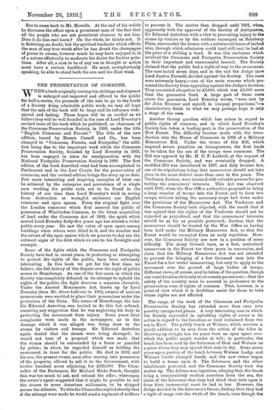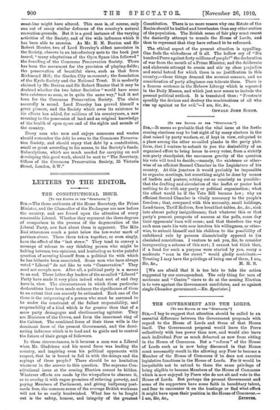THE PRESERVATION OF COMMONS.
-w -HEN a book originally costing ten shillings and sixpence is enlarged and improved and offered to the public for half-a-crown, the proceeds of the sale to go to the funds of a Society doing admirable public work, we may all hope that the sale of the book will be large and its influence wide- spread and lasting. Those hopes will be as cordial as we believe they will be well founded in the case of Lord Eversley's revised issue of the book which he published, as chairman of the Commons Preservation Society, in 1895, under the title "English Commons and Forests." The title of the new edition, issued by Messrs. Cassell and Co., has been changed to "Commons, Forests, and Footpaths," the addi- tion being due to the important work which the Commons Preservation Society, founded by Lord Eversley in 1865, has been engaged in since its amalgamation with the National Footpaths Preservation Society in 1899. The first edition of the book described what had been accomplished in Parliament and in the Law Courts for the preservation of commons, and the revised edition brings the story up to date. Few more interesting and inspiring examples of what can be achieved by the enterprise and persistence of a single man working for public ends are to be found in the history of our time than Lord Eversley's work in saving front destruction or wrongful enclosure our English commons and open spaces. From the original fight over the London commons which first assured the public of possession of Wimbledon Common, to the latest acquisition of land under the Commons Act of 1899, the spirit which moved Lord Eversley forty-five years ago has stirred a wider public every year. He saw the value of open space among buildings when others were blind to it, and the number and the extent of the open spaces which we possess to-day are the outward signs of the debt which we owe to his foresight and example.
Some of the fights which the Commons and Footpaths Society have had in recent years, in protecting or attempting to protect the rights of the public, have been extremely interesting. In this book we get for the first time, we believe, the full history of the diSpute orer the right of public access to Stonehenge. As one of the few cases in which the Society was completely defeated in its attempt to uphold the rights of the public, the fight deserves a separate chronicle. Under the Ancient Monuments Act, drawn up by Lord Eversley (then Mr..Shaw-Lefevre) in 1882, owners of ancient monuments were enabled to place their p-ossessions under the protection of the State. The owner of Stonehenge, the late Sir Edmund Antrobus, was invited to do this but refused, resenting any suggestion that he was neglecting his duty in protecting the monument from injury. Some years later complaints were made in the newspapers as to the damage which it was alleged was being done to the stones by visitors and tramps. Sir Edmund Antrobus again denied that the stones were being damaged ; he would not hear of a proposal which was made that the stones should be surrounded by a fence or guarded by police; in short, he regarded himself as holding the monument in trust for the public. He died in 1899, and his son, the present owner, soon after coming into possession of the property, offered to sell it to the Government, with twelve hundred acres adjoining, for £125,000. The Chan- cellor of the Exchequer, Sir Michael Hicks Beach, thought this was too much to ask, and refused the offer; whereupon the owner's agent suggested that it might be possible to sell the stones to some American millionaire, to be shipped across the Atlantic. To this the Chancellor replied shortly that if the attempt were made he would send a regiment of soldiers
to prevent it. The matter then dropped until 1901, when apparently with the approval of the Society of Antiquaries, Sir Edmund Antrobus, with a view to preventing injury to ths stones by visitors or by the soldiers encamped on Salisbury Plain, surrounded the stones with a substantial fence of barbed wire, through which admission could (and still can) be had at the price of a shilling a head. It was this enclosure which involved the Commons and Footpaths Preservation Society in their important and unsuccessful lawsuit. The Society claimed that the public had a right-of-way to the monument. The case lasted seven days, and in the end the Judge (now Lord Justice Farwell) decided against the Society. The costs were extremely heavy,—one of the main reasons which pre- vented the Society from appealing against the Judge's decision. They amounted altogether to 23,900, which was £2,500 more than the guarantee fund. A large part of these costs above the guarantee, Lord Eversley writes, "were met by Sir John Brunner and myself, in unequal proportions,"—a characteristic finish to what we may perhaps hope is only a stage of the case.
Another thorny question which has arisen in regard to public rights of common, and in which Lord Eversley's Society has taken a leading part, is the preservation of the New Forest. The difficulty became acute with the intro- duction into the House of Commons in 1896 of a Military Manoeuvres Bill. Under the terms of this Bill, which imposed severe penalties on transgressors, the first lands to be taken for the use of the troops were commons. The Bill was opposed by Mr. H. C. F. Luttrell, at the request of the Commons Society, and was eventually dropped. A modified Bill was introduced in 1897, and duly became law, one of its stipulations being that manoeuvres should not take place in the same district more than once in five years. The Verderers, further, were invested with valuable powers for pro- tecting the commoners' interests. This Act was observed until 1908, when the War Office authorities proposed to bring a large number of troops into the Forest, and to form two camps, without taking the necessary steps laid down under the provisions of the Manoeuvres Act. The Verderers and the Commons Society both objected, with the result that it was agreed that the rights of the Verderers should not be regarded as prejudiced, and that the commoners' interests should be as far as possible protected; further, that the manoeuvres should be treated by the War Office as having been held under the Military Manoeuvres Act, so that the Forest would be exempted from an early repetition. How- ever, the Commons Society are now in a position of some difficulty. The Army Council have, as a fact, authorised manoeuvres in the Forest for three years in succession, and claim that the Military Manoeuvres Act was not intended to prevent the bringing of a few thousand men into the Forest for a few weeks' manoeuvring, but only to apply to the movement over the ground of large bodies of troops. Different views, of course, may be taken of the question, though one consideration obviously must remain paramount,—that the safety of the country must be assured in preference to the preservation even of rights of common. That, however, is a point of view which it is doubtless easier for those to take whose rights are not affected.
The range of the work of the Commons and Footpaths Preservation Society has extended more than once into possibly unexpected places. A very interesting case in which the Society succeeded in upholding rights of access is its action in regard to the foreshore or land reclaimed from the sea in Kent. The pebbly beach at Weimer, which receives a yearly addition to its area from the action of the tides in throwing up shingle, has for years been an open space over which the public might wander at will; in particular, the beach has been used by the fishermen of Deal and Weimer as a place where they may spread their nets to dry. Some seven years ago a portion of the beach between Weimer Lodge and Weimer Castle changed hands, and the new owner began to build a house upon it. The fishermen and the other inhabitants protested, and the Commons Society took the matter tip. The defence was ingenious, alleging that, the beach being a comparatively modern accretion from the sea, the claim of the fishermen that they had dried their nets upon it from time immemorial must be bad in law. However, the Judge decided in the fishermen's favour, finding that they had a right of usage over the whole of the beach, even though the eoast-line might have altered. This case is, of course, only one out of many similar defences of the country's natural recreation-grounds. But it is a good instance of the varying activities of the Society, and of the wide influence which it has been able to exercise. As Mr. E. N. Buxton and Sir Robert Hunter, two of Lord Eversley's oldest associates in the Society, observe in an introductory note to the book just issued, "many adaptations of the Open Space idea followed" the founding of the Commons Preservation Society. There has been the movement for the provision of playing-fields ; the preservation of beautiful views, such as that from Richmond Hill ; the Garden City movement ; the foundation of the Kyrie Society and the National Trust. It is modestly claimed by Mr. Buxton and Sir Robert Hunter that it may be doubted whether the two latter Societies "would have come into existence so soon, or in quite the same way,' had it not been for the Commons Preservation Society. The claim assuredly is sound. Lord Eversley has proved himself a great pioneer, and the Society which owes its existence to his efforts has added, for millions of his countrymen, a new meaning to the possession of land and an original knowledge of the health of open space and of the sights and sounds of the country.
Every man who uses and enjoys commons and wastes should remember the debt he owes to the Commons Preserva- tion Society, and should repay that debt by a contribution, small or great according to his means, to the Society's funds. Subscriptions, which are much needed for carrying on and developing this good work, should be sent to "The Secretary, Offices of the Commons Preservation Society, 25 Victoria Street, London, S.W."



















































 Previous page
Previous page